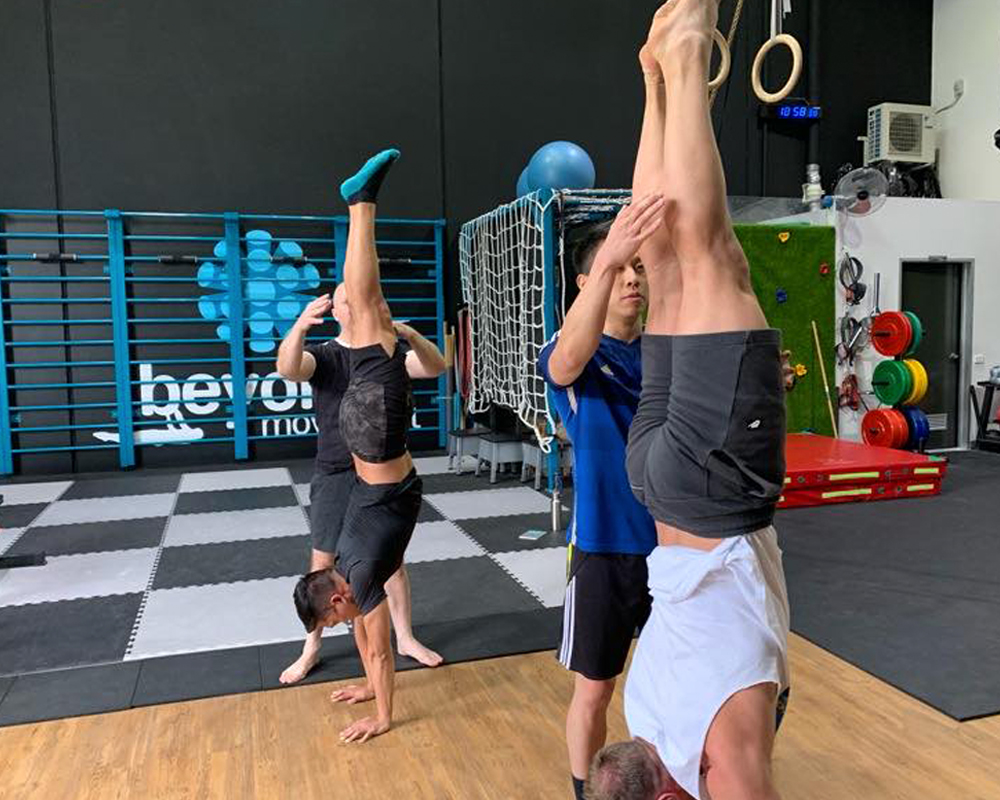
Freestanding Handstand
Master the art of balancing on your hands without wall support. This foundational inversion builds incredible shoulder strength, core stability, and full-body awareness.
Focus Areas
Prerequisites

Freestanding Handstand
Master the art of balancing on your hands without wall support. This foundational inversion builds incredible shoulder strength, core stability, and full-body awareness.
Prerequisites
The freestanding handstand is the cornerstone of bodyweight training and gymnastics. This skill involves maintaining a straight line from wrists to toes while balancing solely on your hands, without any wall support. Beyond its impressive aesthetic, the handstand develops comprehensive upper body strength, enhances proprioception, and builds the kind of core stability that transfers to every other movement practice.
At Beyond Movement, we've guided hundreds of students from their first wall-supported attempts to confident freestanding holds. Our systematic approach breaks down this complex skill into manageable progressions, ensuring safe and efficient progress regardless of your starting point. The handstand isn't just about strength—it's about understanding body positioning, developing patience, and building the neurological patterns that allow for balance.
The journey to a solid handstand transforms not just your physical capabilities but also your mental approach to challenging skills. Each practice session builds focus, determination, and the ability to remain calm under pressure—qualities that extend far beyond the gym.
Prerequisites
Master these skills first:
- 60-second hollow body hold
- 10+ quality push-ups with proper form
- 45-second chest-to-wall handstand hold
- Adequate wrist mobility (90 degrees extension without pain)
- Basic understanding of shoulder elevation and scapular positioning
Common Mistakes
Avoid these errors:
-
Banana back syndrome
Instead: Maintain posterior pelvic tilt and engage core throughout
-
Death grip on floor
Instead: Learn to balance with fingertips, not just palms
-
Breath holding
Instead: Develop calm, controlled breathing while inverted
-
Rushing off the wall
Instead: Build systematic progressions before attempting freestanding
-
Neglecting wrist prep
Instead: Dedicate 5-10 minutes to wrist mobility before each session
Related Skills
Foundation
Hollow Body Hold
The fundamental core position for all gymnastics movements. Master this to unlock handstands, levers, and advanced skills.
Foundation
Push-Ups
Master the fundamental pushing pattern. This versatile exercise builds the foundation for handstands, planche, and pressing strength.
Foundation
Shoulder Mobility
Coming Soon
Variation
Handstand Shapes
Express creativity through different leg positions in your handstand. Develops control and adds variety to practice.
Progression
Handstand Push-Up
Build incredible pressing power with vertical push-ups in a handstand. This skill develops unmatched shoulder and tricep strength.
Progression
Press to Handstand
Elegantly lift into a handstand without jumping. This skill combines exceptional strength with flexibility and control.
Progression
One-Arm Handstand
The pinnacle of hand balancing—supporting your entire body on a single hand. This skill represents years of dedicated practice and refinement.
Progression
Handstand Walking
Take your handstand to the next level by learning to walk on your hands. This dynamic skill builds incredible shoulder stability and control.
